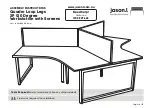
8.2.1
General information about biocompatibility and chemical
resistance
Biocompatibility
The ÄKTA avant instrument is designed for maximum biocompatibility, with biochemically
inert flow paths constructed mainly from titanium, PEEK and highly resistant fluoropoly-
mers and fluoroelastomers. Titanium is used as far as possible to minimize contribution
of potentially deactivating metal ions such as iron, nickel and chromium. There is no
standard stainless steel in the flow path. Plastics and rubber materials are selected to
avoid leakage of monomers, plasticizers or other additives.
Cleaning chemicals
Strong cleaning works well with 2 M sodium hydroxide, 70% acetic acid or the alcohols
methanol, ethanol and isopropyl alcohol. Complete system cleaning using 1 M hydrochlo-
ric acid should be avoided in order to not damage the pressure sensors. If you are
cleaning separation media using 1 M hydrochloric acid, use loop injections of the acid
and make sure that the column is not mounted on the Column Valve V9-C. The Column
Valve V9-C contains a pressure sensor which can be damaged by 1 M hydrochloric acid.
Long time use of 0.2 M HCl connected to the Quaternary Valve Q9 as part of a BufferPro
recipe is acceptable. The solution becomes diluted further down in the system.
If sodium hypochlorite is used as sanitizing agent instead of 2 M sodium hydroxide, use
a concentration up to 10%.
Organic solvents
Reversed phase chromatography of proteins works well with 100% acetonitrile and ad-
ditives trifluoroacetic acid (TFA) up to 0.2% or formic acid up to 5%.
Strong organic solvents like ethyl acetate, 100% acetone or chlorinated organic solvents
should be avoided. These might cause swelling of plastic material and reduce the pressure
tolerance of PEEK tubing. For this reason, flash chromatography and straight (“normal”)
phase chromatography is generally not recommended on the system
Assumptions made
The ratings are based on the following assumptions:
•
Synergy effects of chemical mixtures have not been taken into account.
ÄKTA avant Operating Instructions 29101556 AB
181
8 Reference Information
8.2 Chemical resistance guide
8.2.1 General information about biocompatibility and chemical resistance
















































